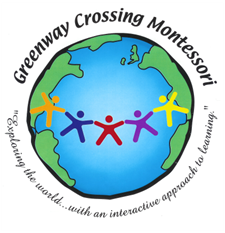
THE MONTESSORI APPROACH TO EDUCATION
To visit a Montessori Classroom is to step into the child’s world of discovery and exploration. The first thing you will notice is the vast array of brightly colored shapes, forms and textures. These are the standard classical brightly painted wooden cubes, cylinders graded as to size, colored cut out numerals and textured letters. There is a busy hum of activity in the room. Children can be seen walking, scrubbing, pouring, working on the floor or at small tables, speaking to each other and constantly using their hands to learn.
This was to become the cornerstone of the Montessori philosophy. Dr. Montessori always emphasized that the hand is the chief teacher of the child. Maria Montessori became interested in education as a young doctor working with disabled children. Noticing their great interest in the equipment and method she used for testing their intelligence - they wanted desperately to touch, hold, and feel - she began to use them with children a learning device. Following success with these children, she began her work with normal children in 1907 when she was invited to organize a school in a reconstructed slum area of Italy.
Her medical background led Dr. Montessori to approach education not in the usual sense, but as a scientist. She recorded and organized her observations of the children and tested the validity of her ideas for aiding them in their growth. Noticing their eagerness to do things by themselves and their resentment when this was not allowed, she instructed them in techniques, but did not correct them when they made a mistake. Rather she created conditions so the child could discover and learn by doing. She did not punish them for rough behavior but taught them the technique of good manners. Dr. Montessori did not command what they should do, but gave them the freedom to choose their activities. The only instruction she gave was that they do not disturb others busily at work. This is the foundation of the educational method that is practiced in Montessori schools today.
While these ideas are no longer revolutionary, present day nursery schools and kindergartens differ from Montessori schools in important ways. Montessori felt that the goal of childhood education should not be to have all the children learn the same facts at the same time, but rather to cultivate each child’s own natural desire to learn. This is accomplished by allowing the child to experience the excitement of learning through his own efforts rather than by being told. The materials stimulate the curiosity of the children and invite them to learn through discovery. They are guided by their own interests and periods of readiness. The child is encouraged to feel that he is forever experimenting.
Imaginative teaching materials are the heart of the educational process. Each Teaching material is designed to be self-corrective so that the child, to a large extent, teaches himself and can see his own mistakes. In particularly it is exciting that learning involves the use of all five senses; taste, smell, hear, touch and see. For example, the child using the sandpaper letters runs his fingers over the letters while he says the sound. In this way, he can see, feel and hear the sound simultaneously. Eventually, he will put moveable letters together to form words.
In other “Sensorial” activities, children can match bells by listening to their pitch, shake cylinders filled with rice, beans or salt to decide which is the loudest or smell bottles filled with fragrances to determine which a identical. In “Practical Life” Exercises, children clean a table, polish shoes, sweep the floor or learn to tie one’s shoes.
The learning materials involve the use of concrete materials in which the child can see, feel and experience for himself. In the Montessori Classroom, children can hold units, cylinders, nouns or fractions in their hands. They can act out verbs, pour water around a peninsula, or build a hexagon out of triangles. They are able to absorb many concepts if they meet them in concrete form.
The role of the teacher in the Montessori classroom differs considerably from traditional teachers as well. A Montessori teacher is a very keen observer of the individual interests and needs of each child. The lessons she presents to the child come from these observations rather than from prepared lesson plans. She carefully watches the progress of each child and keeps a record of his work. She moves among the children unnoticed, guiding and encouraging them individually, but not intruding or interfering. She is patiently waiting for each child to be ready for the next step in a graduated system of learning.
What makes the classroom unique is not only its special teaching apparatus, but its air of order and calm. Self-discipline is taught through example. All activity is guided by a respect for the other children and a respect for the materials themselves.
The Montessori classroom is a combination of discipline and direction, encouragement and cooperation. And in Montessori, as in any true learning experience, it is the child who moves himself toward learning.
WE PROVIDE THE BEST CARE FOR OUR CHILDERN!
We treat every child as our own, dedicating ourselves wholeheartedly to their success.


